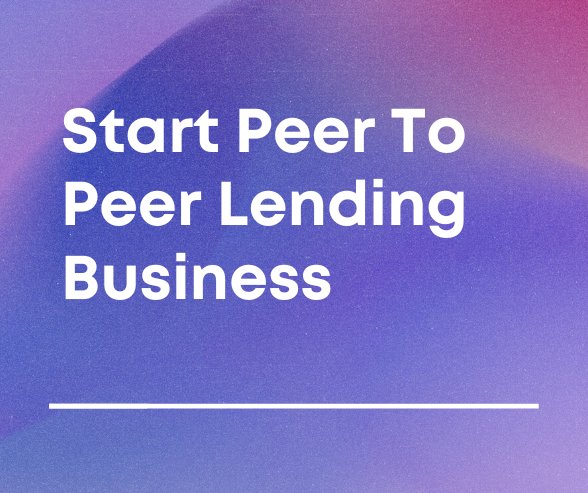Last Updated on May 3, 2023 by David
Peer to peer lending is a type of alternative lending where borrowers and lenders are connected through an online platform. It is a relatively new concept in the financial industry and has gained significant traction over the past few years.
Related Article: How To Start Accounting Business
In this article, we will explore the reasons why someone might want to start a P2P lending business, the advantages of doing so, and how to get started.
What is Peer to Peer Lending?
Peer to peer lending (p2p lending) is a form of borrowing and lending that takes place directly between individuals, without the need for a traditional financial institution like a bank.
It’s facilitated through an online peer to peer lending platform, which connects borrowers and investors. The platform matches borrowers who need funds with investors who are willing to lend them money.
This type of lending has become increasingly popular in recent years, as it provides an alternative to traditional loans that are often accompanied by high-interest rates and strict eligibility criteria.
One of the best p2p lending benefits is that it allows borrowers to access funds that they might not be able to obtain through traditional lenders, while investors can earn higher returns on their money than they might get through other investments.
Peer to peer lending also offers a more personalized and flexible borrowing and lending experience, as borrowers and investors can negotiate the terms of the loan directly with each other.
Why start a Peer to Peer Lending Business?
Starting a P2P lending business can be a lucrative opportunity for those looking to enter the financial industry.
Some of the main reasons to consider starting a P2P lending business include:
- Access to Capital – Starting a peer-to-peer lending platform allows borrowers who might have trouble securing traditional loans from banks or other financial institutions to access capital more easily. As a lender, you can help meet the growing demand for alternative financing options, providing borrowers with access to funds to pursue their dreams and goals.
- High Returns – As a lender, you have the potential to earn higher returns on your investment compared to other low-risk investments like bonds and CDs. By providing capital to borrowers directly, you can earn interest on the loan amount, building a steady source of passive income.
- Build the Best P2P Lending Platform – With the increasing demand for alternative financing options, there is a significant opportunity to build the best p2p lending platform. By creating a user-friendly platform that offers transparent loan terms and competitive interest rates, you can establish yourself as a market leader and attract a large user base of borrowers and investors.
- Disrupt the Traditional Lending Industry – Peer-to-peer lending is disrupting the traditional lending industry by offering borrowers better rates and terms, and investors higher returns. By starting a peer-to-peer lending business, you can help drive this transformation, challenging the status quo and providing consumers with a more convenient and accessible alternative to traditional banks and financial institutions.
Starting a peer-to-peer lending business offers a unique opportunity to provide borrowers with access to capital and investors with higher returns, while also challenging the traditional lending industry.
By building the best p2p lending platform, you can establish yourself as a market leader and significantly impact the financial services industry.
Steps For Starting a Peer-to-peer Business
Here are the crucial steps for starting a peer to peer lending platform.
Step1. Conduct Market Research and Analysis
Conducting market research and analysis is a crucial step in starting a peer-to-peer lending business.
Before you start building the best p2p lending platform, it’s important to gather information about the market you plan to enter.
This research will help you understand the demand for peer-to-peer lending services and identify gaps in the market that your platform can fill.
Here are some key points to consider when conducting market research:
- Identify your target audience: Who are the potential borrowers and investors? What are their characteristics, needs, and preferences?
- Analyze your competitors: Who are the existing peer-to-peer lending platforms? What are their strengths and weaknesses? What gaps can you fill in the market?
- Evaluate the regulatory landscape: What are the legal and regulatory requirements for starting a peer-to-peer lending platform? What are the risks and challenges you may face?
- Determine the market potential: What is the size of the market? What is the projected growth of the industry?
By conducting thorough market research and analysis, you can clearly understand the peer-to-peer lending landscape and make informed decisions about how to build the best p2p lending platform.
Step2. Ensure Legal and Regulatory Compliance
When starting a peer-to-peer lending platform, it is crucial to ensure legal and regulatory compliance to avoid any legal repercussions in the future.
The best P2P lending platforms have robust legal frameworks that safeguard both borrowers and investors.
There are several steps involved in ensuring legal and regulatory compliance when starting a peer-to-peer lending business.
Firstly, you need to familiarize yourself with the laws and regulations that govern the P2P lending industry in your region.
This may include registration and licensing requirements and compliance with state and federal regulations.
It’s also essential to clearly understand the risks involved in P2P lending and develop strategies to protect both the borrower’s and investor’s interests.
This may involve implementing credit risk assessment procedures, setting competitive interest rates, and having a collection process in place for defaulters.
Lastly, you should also take measures to protect your platform from fraud and cybersecurity threats. This includes robust security protocols to safeguard sensitive borrower and investor data.
Overall, ensuring legal and regulatory compliance is critical in building a successful peer-to-peer lending platform.
By following these guidelines, you can build a platform that’s compliant with the law and fosters trust and credibility with your users.
Step3. Develop a Business Plan
A solid business plan is crucial in starting a successful peer-to-peer lending platform.
A well-crafted plan will serve as a roadmap to guide you through the various stages of building the best p2p lending business.
Here are some key elements that should be included in your business plan:
- Executive Summary: This section should provide an overview of your business and highlight the key points of your plan.
- Company Description: This section should describe your company and its mission, as well as the services you will offer.
- Marketing and Sales Strategies: This section should outline your plans for promoting your business and acquiring customers.
- Financial Projections: This section should include financial projections for the first few years of your business, including income statements, cash flow statements, and balance sheets.
- Risk Assessment: This section should identify the potential risks your business may face and provide strategies for mitigating those risks.
By developing a comprehensive business plan, you’ll have a better understanding of the market and competition and a clear roadmap for achieving your goals as a peer-to-peer lending platform.
Step4. Choose the Right Technology Partner
Choosing the right technology partner is crucial when building a peer-to-peer lending platform. It’s essential to select a partner who can provide the best p2p lending solution that meets your specific needs.
Here are some factors to consider when choosing a technology partner for your peer-to-peer lending business:
- Expertise: Look for a technology partner who has experience in developing peer-to-peer lending platforms. Check their portfolio and case studies to determine their level of expertise in the field.
- Customization: A one-size-fits-all solution may not work for your business. Ensure that the technology partner can provide a customized platform that meets your unique requirements.
- Scalability: Choose a technology partner who can develop a scalable platform that can handle increased traffic and users as your business grows.
- Security: Peer-to-peer lending platforms deal with sensitive financial information. Ensure that your technology partner can provide robust security features that protect your users’ data.
- Integration: The technology partner should be able to seamlessly integrate the platform with other systems such as payment gateways, CRM, and analytics tools.
By carefully selecting a technology partner who meets these criteria, you can build a peer-to-peer lending platform that offers the best p2p lending experience to your borrowers and investors.
Step5. Build a Strong Network of Borrowers and Investors
To build a successful peer-to-peer lending platform, it’s important to have a strong network of borrowers and investors. Here are some strategies for building this network and attracting the best P2P lending candidates:
- Establish a professional online presence: Create a user-friendly website that showcases your lending platform’s features and benefits. This will help attract potential borrowers and investors to your platform.
- Develop a marketing strategy: Use a mix of digital marketing tactics, such as social media advertising, email marketing, and search engine optimization, to promote your platform to your target audience.
- Offer competitive interest rates: To attract borrowers, offer competitive interest rates that are lower than traditional bank rates.
- Build trust and credibility: Provide borrowers and investors with detailed information about the lending process, including fees and interest rates. This will help establish trust and credibility with your audience.
- Leverage technology: Use technology to streamline the lending process, such as automated underwriting and loan processing. This will help you attract borrowers and investors who value efficiency.
By following these strategies, you can build a strong network of borrowers and investors that will help your P2P lending platform thrive.
Step6. Establish a Risk Management System
Establishing a comprehensive risk management system is crucial for the success of a peer-to-peer lending platform.
A solid risk management system helps protect both the borrowers and investors, thereby building trust and credibility in the platform.
Here are some important steps to consider when establishing a risk management system for your peer to peer lending platform:
- Conduct a thorough best p2p lending risk assessment to identify potential risks and threats to the platform
- Establish clear criteria for selecting borrowers and investors
- Implement a system for verifying borrower and investor identities and creditworthiness
- Set up a system for monitoring borrower repayment behavior and identifying delinquencies
- Establish a protocol for dealing with delinquent borrowers, including collection processes and legal action if necessary
- Implement measures to protect against fraudulent activity, such as identity theft and loan stacking
- Implement strong cybersecurity measures to protect the platform and user data
By establishing a robust risk management system, your peer to peer lending platform can minimize risk exposure and build trust and confidence among borrowers and investors, leading to a more successful and sustainable business.
Step7. Develop a Customer Service Strategy
A strong customer service strategy is crucial for any business, and a peer-to-peer lending platform is no exception. When developing a customer service strategy for your peer-to-peer lending platform, it’s important to keep the borrower and investor experience at the forefront of your mind. Here are a few tips to consider when building the best p2p lending customer service strategy:
- Address customer complaints and queries promptly and professionally.
- Provide personalized services to your borrowers and investors.
- Build customer loyalty through exceptional service.
- Use data analytics to track customer behavior and preferences.
- Offer multiple channels of communication, such as email, phone, and chat support.
- Invest in employee training to ensure they are equipped to handle customer inquiries.
- Continuously improve your customer service strategy based on feedback from borrowers and investors.
By implementing a strong customer service strategy, you can differentiate your peer-to-peer lending platform from competitors and build a loyal customer base.
Step8. Build a Team
Building a strong team is a critical aspect of creating a successful peer to peer lending platform.
To build the best p2p lending team, you need to hire key personnel with the necessary skills and experience to help you achieve your business goals.
It’s important to look for individuals who are knowledgeable about the lending industry and have experience working in financial services.
You should also seek individuals with strong communication skills who can provide excellent customer service to your borrowers and investors.
Once you’ve hired your team, you need to provide them with the training and development they need to excel in their roles.
Create a positive work environment that fosters collaboration and encourages innovation.
A successful peer-to-peer lending business requires a team that is committed to providing the best possible service to your customers.
By hiring the right people and investing in their development, you can create a team that is dedicated to helping you achieve your business goals and build the best p2p lending platform.
Step9. Manage Your Finances
When starting a peer-to-peer lending business, it’s important to have a solid financial management plan in place to ensure the sustainability and profitability of your platform. Here are some key considerations for managing your finances:
- Fund Management: Managing the funds that flow through your platform is crucial to its success. You will need to set up systems to track loans, interest payments, and investor returns. It’s also important to have a plan in place for managing defaults and delinquencies.
- Accounting and Bookkeeping: Keeping accurate records of your platform’s financial transactions is essential for tax compliance and financial reporting. This includes tracking revenue, expenses, and investments.
- Tax Planning and Compliance: To avoid legal issues and penalties, you’ll need to stay up-to-date on tax laws and regulations related to peer-to-peer lending. It’s important to consult with tax professionals and legal advisors to ensure compliance.
By effectively managing your finances, you can ensure the long-term success of your peer-to-peer lending platform.
Conclusion
Starting a peer-to-peer lending business can be a lucrative venture if done properly. It requires careful planning, market research, legal compliance, and effective financial management.
By following the steps outlined in this article, you can build a successful peer-to-peer lending platform that attracts both borrowers and investors.
It’s important to choose the right technology partner, build a strong network of borrowers and investors, establish a risk management system, and provide excellent customer service.
With the growing demand for alternative lending options, the peer-to-peer lending industry is poised for continued growth.
By offering the best p2p lending experience, you can position your platform for success in this dynamic market.




